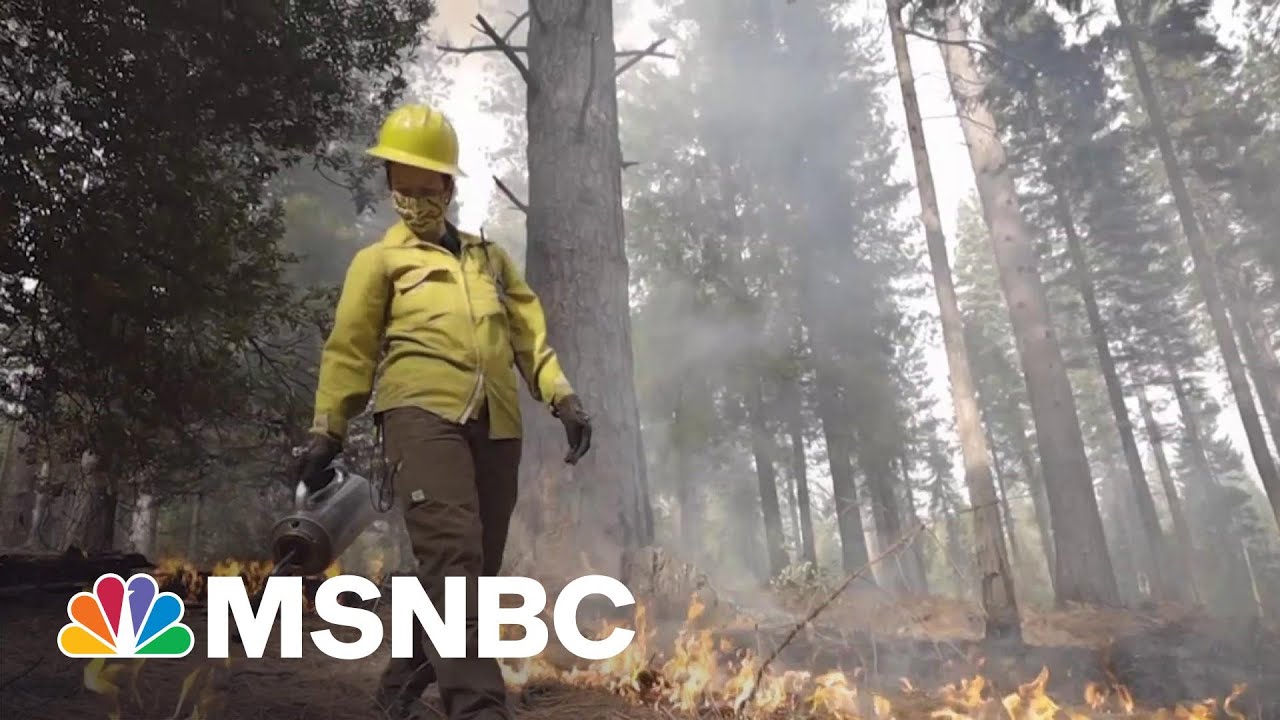NBC’s Jacob Ward reports from California where scientist are preparing for wildfire season by setting controlled fires. Aired on 04/23/2021.
» Subscribe to MSNBC:
About Craig Melvin: Craig Melvin is an MSNBC Anchor and NBC News Correspondent. He currently anchors “MSNBC Live” on Saturdays and Sundays, contributes reports for “TODAY,” and fills in as host for Lester Holt on “Weekend TODAY.”
MSNBC delivers breaking news, in-depth analysis of politics headlines, as well as commentary and informed perspectives. Find video clips and segments from The Rachel Maddow Show, Morning Joe, Meet the Press Daily, The Beat with Ari Melber, Deadline: White House with Nicolle Wallace, Hardball, All In, Last Word, 11th Hour, and more.
Connect with MSNBC Online
Visit msnbc.com:
Subscribe to MSNBC Newsletter:
Find MSNBC on Facebook:
Follow MSNBC on Twitter:
Follow MSNBC on Instagram:
#California #Scientists #MSNBC
California Scientists Are Fighting Fire With Fire | Craig Melvin | MSNBC







How to clear the undergrowth? GOATS.
Or we could just rake the forest like the last Prez said 😁
Pigs
There’s only about 48 million acres of federal land in cali.. how many goats would that take?
That doesn’t clear the tree canopy so the undergrowth comes back to prevent mud slides…
Call me crazy, but a healthy forest would have large animals preventing dead vegetation from becoming a fire hazard, why pollute the air by burning dead plants to prevent pollution from wildfires??
@Komenisai dead vegetation should also be broken down by animal activity, not just decomposers, I’m sure some plants benefit from the aftereffects of wildfires but the pollution cost of man-made controlled fires feels avoidable
@E E I’m saying there should be solutions other than relying on human practices hundreds of years ago, there’s a whole new preventative technique of wrangling large herbivorous animals to keep fire hazards from piling up (holistic management where animals need water, animals eat dead plants, new plants need animal waste)
I don’t doubt that some trees evolved to survive the aftereffects of natural wildfires but pollution should be the main issue if people start believing we have no other choice but to continue to burn dead plants to avoid bigger wildfires,
the real problem is how vulnerable and non-resistant forests are to droughts and freak fire accidents, if we “watered” the land w/ animals that risk is mitigated
@Richard Wong People have been using fire for thousands of years and it has never been a problem for the environment. I don’t know what it’s like in America but here in Australia some of our native plants wont germinate without fire.
Sorry quick edit: it’s the smoke from the fire not the fire itself
@Buddy Christ I agree thousands of years ago the effects of bush fires were negligible, but in the modern era w/ climate change worsening droughts and fire hazards people need to rethink its options;
there’s an organization led by this ecologist named Allan Savory that tries to prevent forest fires (and other environmental disasters) by simply wrangling animals;
it sounds crazy, but animals need water, animals eat dead vegetation, new plants need animal waste; managing the land in this way also prevents forest fires
@Richard Wong It sounds cray because it is. Animals don’t eat dead plants, they will eat the living stuff and leave everything that is dead.
Speaking from personal experience (3 towns in my area were burnt to the ground during the last bush fire season) that is the kind of BS that makes things worse.
Maybe we should take lessons from the Native Americans. They knew how to live with the land, why can’t the rest of us learn?
Every civilisation on earth has known about burning forest is good for growing new plants. That is nothing unique to native Americans. Many of the settlers coming from Europe had used the same methods themselves.
This news guy reminds of a younger version of the dad on Eddy Murphy’s old movie Coming to America
Will there be nesting material for birds and mammals?
Will there be nesting materials for birds, squirrels, chipmunks, etc.?
Animals generally move out of the way and come right back, grasses come back the next summer and can be used for nesting materials.
There was an accidental study in Colorado last year where a herd of tracked elk moved out of the way and came right back days later.
Yes, with controlled fires the big trees survive fairly well.
Controlled burns were used for a long time in much of the west’s forrests. For this very reason.
The mountain Sequoia need fire to release their seed pods, as do many different vegetations thriving in forrests.
US dept of Forestry along with states like CA, OR, WA, NV, UT, and CO at least used to do controlled burns in differing sections of Forrest on a regular basis. There were a few, if I remember correctly, situations where the controlled burns went out of control spurring a more severe forest fire, but for the most part they did more good than bad. CA always had it’s fire seasons even with controlled burns…but I believe the controlled burns were in the actual forrests not in the scrub. Many out of control fires are in the densely overgrown scrub brush and oak groves.
According to the game show host of the the last 4 years, you need to rake the forest ?
Controlled burning happens all across the midwest. I was just trying to introduce some Sarcasm. The former president was dumb as a rock.
@Jonathan Mol Please stop insulting rocks.
Lodgepole pines pinecones don’t activate until they reach a certain temperature. And the undergrowth needs to be burnt to keep forests clear.
Animals mainly move out of the way and come right back, there was a cool study in Colorado last summer by accident of an elk herd that had trackers on them coming right back when the fire passed.
@Nancy Ross I think that besides climate change–which is a huge part of this, people are moving more and more into the ‘wilderness’. This creates a huge problem because as the forests and scrub lands do their thing (burning from time to time, to get rid of some things and bring life to other things) it now encroaches on our home’s and livelihood ‘s.
I don’t think that folk will move out of these fire zones, so I guess those that choose to live in them need to better prepare for fire. Building homes that are not easily burned, having yards landscaped as to help keep it from coming in… whatever that means, lol, and clearing brush that is beyond their yards. Or realize they are in danger come fire season, and my understanding is that fire season is growing in CA.
Im no scientist, but I absolutely see a need here for the controlled burns…but then again the forests do it anyway and when we as humans try to help nature……well we’re screwed
If they let responsible people live in the forests to care for them the stuff that needs to be burned would be used to sustain the people living there putting the people and the forest to use at the same time. A win win. Plus improvement of the forest. Triple win.
But who is going to RAKE the forest floors though!?!?! 😂🤣
They are gonna burn the underbrush, probably gonna have imates do it too
Climate challenge 😆🤡🐑
We must ally with fire or it will burn uncontrollably.
There is a greater lesson in this: Just like with sneezing, don’t jump to conclusions about what is good and bad. Sometimes, what seems bad might actually be good. Also, don’t just write off more “primitive” societies as if they know fewer things or their understanding is without value.
flash burning, I have done that and that is what Native Americans did.
Good, the forests need to be cleared with fire. Also there are many plants that need fires to thrive, lodgepole pines need fire or their pinecones stay dormant.
Forest service & forestry scientists has been doing/studying this for decades
ขอให้กลับไปได้เร็วๆ ด้วยบุญบารมีขององค์สัมมาสัมพุทธเจ้า ประทานพร อันศักดิ์สิทธิ์ ขอพรอันประเสริฐ สาธุสาธุสาธุ
เราเข้าใจผิด เข้าใจเรานะ
It’s telling how all US news sounds very condescending in their intonation and writing. To the rest of us abroad it’s incredibly irritating, like speaking to a child.
The key is to have frequent low intensity fires that can burn through the understory without damaging mature trees. The complete suppression of fires results in such high fuel loads on the forest floor that the resultant wild-fires cant be contained.
I think the solution to houses in areas adjacent to controlled burns would be *mandatory* fire breaks, and limits on plant density immediately next to the structures.
Before anyone gets their knickers in a twist about the government telling folks what to do with their property, I’m just going to point out that this stuff is happening in state and national forests, so there are already limits on what land buyers can do, and they know going into the deal that they are only buying the right to build on state land.